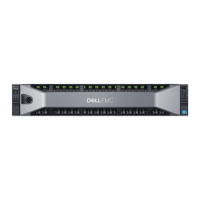4-10 Dell PowerEdge 6100/200 System User’s Guide
Second I/O APIC
If this category is set to Enabled, the operating system
reports the second I/O Advanced Peripheral Interrupt
controller (APIC) in the MPS tables. The default setting
is Disabled.
PIC Interrupt Routing
When this category is set to Through IO APIC, the inter-
rupt mapping connects to the microprocessor’s local
APIC through the I/O APIC. When set to Default (the
default), the INTR and NMI signals are connected
directly to the microprocessor’s local APIC, bypassing
the I/O APIC.
IOQ Depth
This category sets configures the In-Order Queue to sup-
port a specified number (8, 1, or Auto Configure
[default
setting]) of pending pipelined transactions on the micro-
processor bus.
GAT Mode
Options are Aliased (default) and Normal.
Outbound Posting
This category is used to enable or disable (default setting)
write posting to the PCI bus from the microprocessor bus.
PCI Line Prefetch
This category is used to enable (default) or disable up to
three additional cache lines in response to PCI Line Read
and PCI Read Multiple commands.
Addr Bit Permuting
If this category is set to Enabled, the memory controller
will swap high-order row selection bits with low-order
bits when computing the effective memory address. The
default setting is Disabled.
Chip Set Register Settings
This category configures several performance features of
the computer chipset based on the chipset’s hardware
revision level. The recommended setting is Auto Config-
ure, which allows the BIOS to optimize these settings
based on your system’s chipset.
AERR Mode
This category enables (the default setting) or disables
address parity error detection on the microprocessor bus.
EERR Mode
This category enables or disables (the default setting)
system reporting of EISA bus time-out errors.
PERR Mode
This category enables or disables (the default setting)
detection of PCI bus protocol violations.
Plug and Play Configuration Submenu
The following categories appear in the Plug and Play
Configuration submenu.
Latency Timer (PCI Clocks)
This category ensures that a PCI card can access the PCI
bus within the specified number of PCI clocks.
Boot With PnP OS
This category is used to determine how the non-boot
devices are initialized. If this category is set to None (the
default), the BIOS initializes all non-boot devices. If set
to Other, the operating system initializes all non-boot
devices. Windows 95 is not an option on this system.
Security Menu Categories
This section explains the system setup categories in the
Security menu (see Figure 4-6).
The Dell PowerEdge 6100 systems feature several levels
of security features. You can set up a user password to
restrict system access at system boot, and following peri-
ods of system inactivity. Several of the security features
can be also configured using the system configuration
utility. (Some security category names are slightly differ-
ent in the system configuration utility.) You can restrict
access to the system configuration utility using the
administrative password, as described in Chapter 5.

